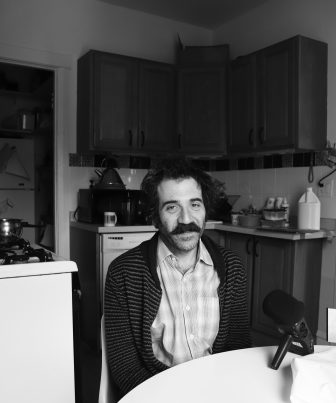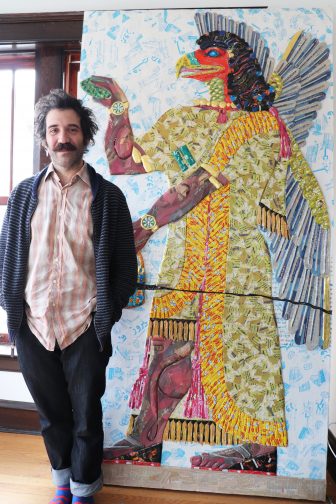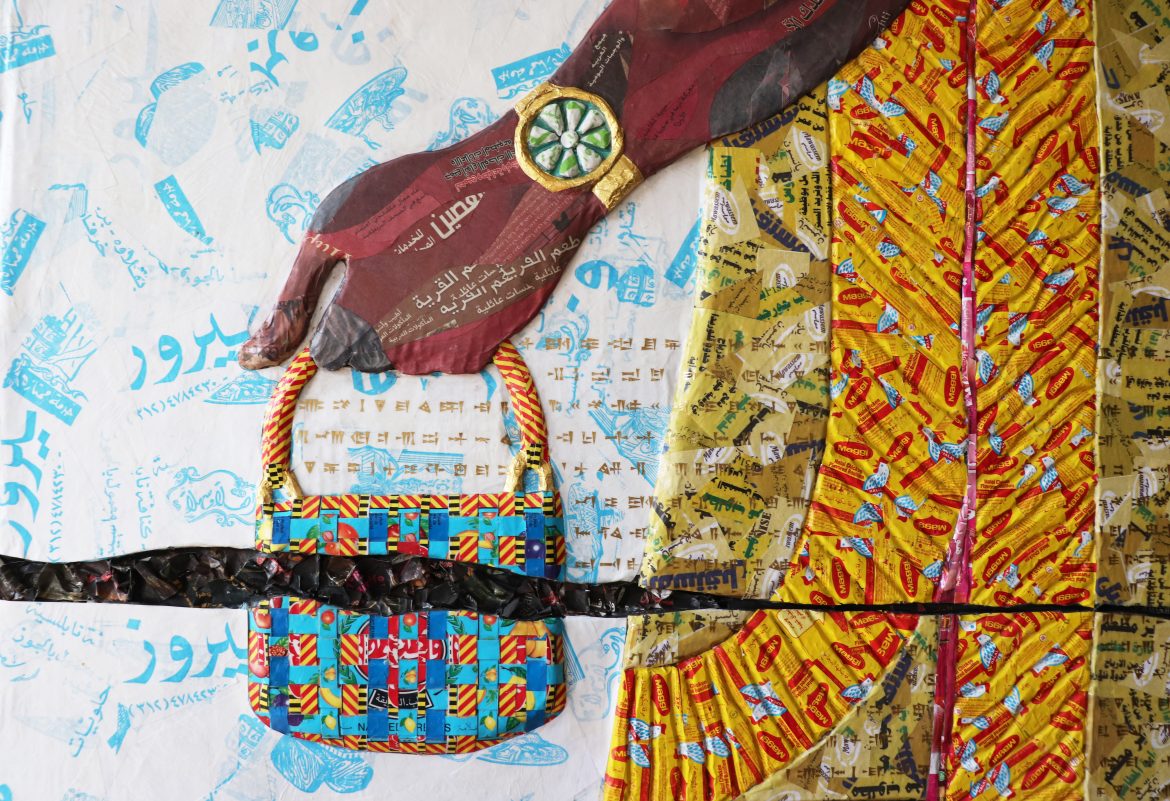There’s a myth circulating about the 2019 Whitney Biennial. It goes something like this:
A Chicago artist named Michael Rakowitz withdrew from the Biennial in protest because Whitney Vice Chairman Warren B. Kanders owns Safariland, a company that sells teargas canisters the US Border Patrol uses against refugees seeking asylum.
As with all effective myths, this one has some truth to it.
Warren B. Kanders is indeed a vice chairman at the Whitney Museum of American Art, and he has, since 2012, owned Safariland, a company that manufactures weapons, including teargas canisters that have recently been used by US Border Patrol agents against refugees seeking asylum. And Michael Rakowitz is from Chicago. And he was, indeed, invited to participate in the 2019 Whitney Biennial.
But Rakowitz did not withdraw from the Biennial in protest over Kanders’ presence on the museum’s board. Not exactly. It was more like he made a private choice. Protest isn’t the word. “I prefer the word fast,” says Rakowitz, “to mark it as a moment also related to imperfection, penitence, and looking, perhaps hopefully, to the breaking of a fast, should the situation one day resolve.”
The story of how Rakowitz became labeled as the 2019 Whitney Biennial protestor began on Feb. 25, 2019, the day the museum announced its official artist list for the Biennial. The announcement spotlighted two milestones achieved by Jane Panetta and Rujeko Hockley, the curators: they had curated the most equitable Whitney Biennial ever in terms of racial and gender parity; and, for the first time, each Biennial artist will be paid ($1500) for participating in the show.
But instead of focusing on those triumphs, The New York Times broke the story with the muckraking headline: “The Whitney Biennial: 75 Artists Are In, and One Dissenter Steps Out.” Veteran arts journalist Jillian Steinhauer wrote: “This year’s Whitney Biennial, considered the country’s most important showcase of contemporary art, has 75 participating artists—and one who has already withdrawn.” Steinhauer continued, “before the list of participants was even released, a Chicago-based artist, Michael Rakowitz, pulled out of the exhibition in a protest against a museum vice chairman, Warren Kanders. Mr. Kanders is the chief executive of a company that manufactures equipment, including body armor and tear gas, for law enforcement agencies and militaries.”
Within days, Hyperallergic, The Art Newspaper, and several other art media outlets followed the lead of The Times, re-reporting that Rakowitz had withdrawn from the Biennial in protest—and the die was cast.
I live ten minutes away from Rakowitz, whose home and studio is located in the Edgewater neighborhood of Chicago. I’ve heard him called a “protest artist” and “activist artist” before—one-dimensional descriptions I feel ignore the more nuanced and constructive aspects of his projects. So when I read the flood of media reports coming out about him, I wondered if this dismissive trope was being employed against him again.
I reached out to Rakowitz for an interview. Meanwhile, I contacted Steinhauer at The Times to confirm that Rakowitz had told her he was protesting the biennial.
Steinhauer responded, “The choice to use the word “protest” was mine; it seemed like an appropriate descriptor for his action, especially in the context of all the other protests happening around Kanders’ presence on the Whitney board, as well as protests against board members at other museums that have been happening of late.”
Steinhauer has been reporting on Mr. Kanders’ presence on the Whitney Board for years. Writing for Hyperallergic, she was the first to draw attention to Kanders’ business activities in the weapons industry, and to question how the industry’s ethics fit with the mission of a major American contemporary art museum. She has done everything right. She raised an important cultural question at the heart of the art field. Yet, aside from rousing activists to the cause, her investigation has not instigated any movement from the Whitney leadership regarding the ethical framework under which they raise funds. This is the context that informed her understanding of what Rakowitz did.
The Times article buoyed public awareness of a host of other concerns surrounding the Whitney. It helped spotlight a letter that more than 100 Whitney staff members recently presented to Adam D. Weinberg, the Director of the museum, asking for changes in how board members are chosen, and addressing the inherent conflicts between Mr. Kanders’ business dealings and the daily realities of the working people who keep the museum running. It drew attention to calls for action that Working Artists and the Greater Economy (W.A.G.E.) has been making for a long time for the biennial to compensate artists. ($1500 is the amount W.A.G.E. recommended as a minimum.) It also spurred increased media coverage of Decolonize This Place, a loose-knit activist collective currently mounting its own ongoing protests against the Whitney.
Whether any of this is good or bad may depend on your personal politics. But I couldn’t help thinking the narrative The Times article spun about Rakowitz was hyperbolic at best; or false at worst.

Photo of Michael Rakowitz by the author for Tikkun.
Rakowitz agreed to an interview with me. We sat for two hours in the kitchen of his studio, and over hot tea, in front of dual podcast recorders (his and mine), he shared his saga.
In August of 2018, Rakowitz received his first email from the Whitney—a request for a studio visit from Curatorial Assistant Ramsay Kolber. Unsure of the purpose of the studio visit, Rakowitz said yes. Then when Kolber realized Rakowitz was in Chicago, not New York, she requested a Skype meeting instead. Rakowitz agreed. When that virtual studio happened, on Monday, September 17, Jane Panetta was on the call. She talked with Rakowitz about his work for about 45 minutes, never mentioning the Biennial. About a month later, Panetta and Rujeko Hockley conducted a second Skype interview with Rakowitz, this time inviting him to participate in the 2019 Whitney Biennial.
Says Rakowitz, “They wanted to show The Ballad of Special Ops Cody (2017), and perhaps something sculptural.”
Elated, he said yes and signed the nondisclosure agreement that day, as did his studio assistants. A few weeks later, Panetta flew to Chicago and met Rakowitz in person at his exhibition at Rhona Hoffman Gallery, which included his Room Z, Northwest Palace of Nimrud (2018). During that visit, Panetta expressed the museum’s desire to have Rakowitz make something similar for the Biennial to be installed in the Whitney’s lobby entrance.
This was a dream come true for Rakowitz. He began formulating a plan for his imagined lobby installation. But his dream soon hit a stumbling block. He read a media report about Safariland teargas canisters being used on refugees at the southern border of the United States. It reminded him about the controversy surrounding Kanders’ board position at the Whitney.
For two decades, Rakowitz has been making work that exposes systems and structures within the culture that lead to injustices like poverty, bigotry, inequity, and war. Seeing photos of empty Safariland teargas canisters along with the faces of tear-drenched refugees affected Rakowitz in an immediate, visceral way. He was wracked with questions of how his work could ever function within an exhibition supported directly and materially by the very systems and structures he has spent his professional life trying to subvert.
He read everything he could about the situation. He perused Steinhauer’s earlier reporting on the connection between Kanders and the Whitney, and studied the letter the Whitney staff had sent to Mr. Weinberg. Thoroughly conflicted, he reached out to Panetta and Hockley. The curators embraced his intellectual journey, encouraging him, if he liked, to make work specific to his feelings about the topic, which could be included in the Biennial.
Rakowitz acknowledged many excellent reasons to move forward: his respect for the curators; the fact that the Whitney Biennial is a massive stage on which to present his aesthetic and social concerns; and the fact that innumerable other artists struggle their entire lives and never get offered an extraordinary chance like this to share their work with the world.
But he also saw one glaring reason not to participate: he could not imagine a scenario in which his work would not merely be appropriated to serve the narrative that the Whitney was not acting unethically in partnering with a weapons manufacturer since they were also democratic enough to allow artists to prominently voice their dissent during the Biennial.
Rakowitz did not want the entanglement of being misunderstood, nor the stress of being used as a PR pawn, so he decided to withdraw. Fully at peace with his decision, he was nonetheless conflicted about whether to withdraw in a public or private way.
“I considered the possibility that going public might be the most responsible thing to do,” says Rakowitz, “but I also know that: 1) singular voices are easy for institutions to ignore; 2) I did not want my decision to be one where the vectors of attention/awareness point back to one artist instead of the issue, and; 3) I believed I could make my stance known to the people that mattered most—the curators and director of the Whitney—without engaging publicly, which can often lead to shaming instead of the actual structural work to be done in addressing these very big problems.”
Ultimately, Rakowitz chose to withdraw privately, and expressed his complex feelings in a heartfelt letter to Panetta and Hockley—a letter he says was intended “for their eyes only.”
Shortly afterward, however, his decision to withdraw from the Biennial was leaked to the press.
As soon as he realized his decision was going public without his consent, Rakowitz attempted to get ahead of the story. He reached out to Steinhauer at The New York Times.
“I shared my letter with her in confidence,” Rakowitz says, “and explained my rationale for not wanting to go public.”
Meanwhile, also mindful of the leak, Whitney decision makers decided to release their list of Biennial artists—which did not include Rakowitz—early, hoping to spin the story with positive talking points about the most inclusive, diverse, and economically fair Whitney Biennial ever.
We know what happened next: a hyperbolic headline in the newspaper of record transformed a thoughtful, private decision into an act of public protest.
The tone of The Times article made it impossible for other media outlets to extract the bombastic protest narrative from the announcement of the list of biennial artists. This tactic was commonly used by The Diggers—a 1960s-era San Francisco-based, guerrilla theater troupe led by Peter Berg. It’s called “creating the conditions you describe.”
His back firmly against the wall, Rakowitz released a prepared statement to Hyperallergic, culled from the letter he wrote to the Whitney curators, attempting to enlarge the narrative by clarifying his solidarity with the demands of the Whitney staff members who had sent that letter to Weinberg a while back. That effort did not fare well. Instead of being acknowledged as one small player in a massive effort, Rakowitz has become known as the 2019 Whitney Biennial protestor.
Reality is less exciting than the news. Rakowitz merely made a choice. Rather than saying yes to one thing, he said yes to something else. The installation he imagined for the Biennial is still in production in his studio, and will be shown at another museum. He feels no animosity. In our conversation, in fact, he went on record that he met with Weinberg in person in New York to discuss the issue.

Michael Rakowitz standing in front of “The invisible enemy should not exist (Northwest Palace of Nimrud, Room G),” 2019, Middle Eastern food packaging, newspapers, cardboard and glue. (Photo by the author for Tikkun.)
“One of my mentors in the field of public art replied to my request for advice when I was grappling with my decision,” says Rakowitz, “to let me know that Mr. Weinberg is not an unsavory player in all this. So I went into my meeting with him on January 18, 2019—nearly a month after I wrote my letter—knowing he was in a tough position. The meeting was warm, he was grateful for my letter, and I left knowing he was the kind of person for whom the process of building a board would shift significantly in light of all that has happened. We also discussed reform for how museums could adopt criteria for boards in similar ways that best practices are adopted for the exhibition of artworks. Thus, my analogy that a museum would not compromise the integrity of a work on paper by showing it in an unsafe environment; why then would a museum compromise the integrity of an artist by asking them to show with permission and funding from someone making conditions unsafe for others?”
It’s worth pointing out that if Rakowitz is right, and Weinberg is now moving forward towards adopting such reforms, that change will not be rooted in hyperbolic outrage theater. It will be rooted in the fact that people met and had a conversation.
Regarding Kanders, Rakowitz recalled to me something the Dalai Lama once advised thinking about in the aftermath of terrorist attacks. He suggested that instead of exacting revenge we might start by asking the terrorists what had happened to them in their lives to make them capable of committing such violence.
We might just as well ask what happened to Kanders in his life to make him so committed to the military industrial complex. What happened to make him so committed to contemporary art? What is it about his personal story that makes it hard for him to sympathize with the pain his products cause? What happened to make him immune to the conflict his choices have sparked? Shaming him and demanding his removal from the board of a museum denies a basic fact of humanity: that we contain multitudes.
The Whitney is just a museum. It has space and money, but the space is useless without new art to fill it, and the money is just a tool with which to acquire and exhibit that new art.
Artists have the power. They don’t have to adhere to any social or political agenda, nor employ any particular method, nor make any particular kind of work. The only thing they have to do to claim their power is create art that offers something of value to humanity.
When art resonates with people, it influences the rollout of human culture; it commands public attention; it influences the decisions made by gallerists, academics, and foundations; and it forms the pools from which museum curators curate.
In addition to Steinhauer and Rakowitz, I invited all the other players in this story to share their insights.
Mr. Kanders ignored my request for an interview.
A Whitney Communications Associate deflected my multiple interview requests. Her most recent response, several weeks in, was, “Thanks for following up. I don’t have an update at this time.”
Representatives from Decolonize This Place agreed to talk with me, but repeatedly failed to follow through.
A representative of W.A.G.E. talked with me at length about how that organization has been inaccurately lumped in with the protests and alleged protests, sparking unfair social media criticism for supposedly overreaching its mission to fight for fair wages for artists.
In the end, whether they claim their voice or not, they are all part of what is becoming the most grandiose social practice art project of the decade. Rakowitz is a collaborator in it, so is Kanders, Weinberg, Steinhauer, Panetta, Hockley, Decolonize This Place, W.A.G.E., the editors of The Art Newspaper, Hyperallergic, and The New York Times, along with the Whitney staffers, every artist in the 2019 Whitney Biennial, and every visitor to the exhibition.
What the end result of the project will be is anyone’s guess. Maybe it will be a net positive for the culture.
Either way, we in the art media need to think more carefully about the shit storms we whip into shape with our little word wings every time we get it wrong.
It’s easy to use the word protest instead of the word choice. It’s easy to villainize individuals and organizations. It’s easy to throw artists and their work aside in service to activist agendas.
It’s more difficult to give people their full measure; to let them tell their whole story; to believe in the potentiality of conversation; and to make a safe space for intelligent, thoughtful, compassionate people to disagree about important things.
The musician Tom Waits said, “The world is a hellish place, and bad writing is destroying the quality of our suffering.” In this case, incomplete reporting has inflicted suffering upon artists, and deflected attention away from art.
